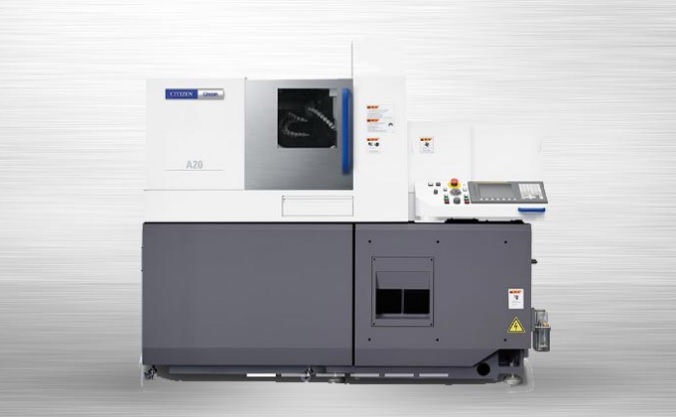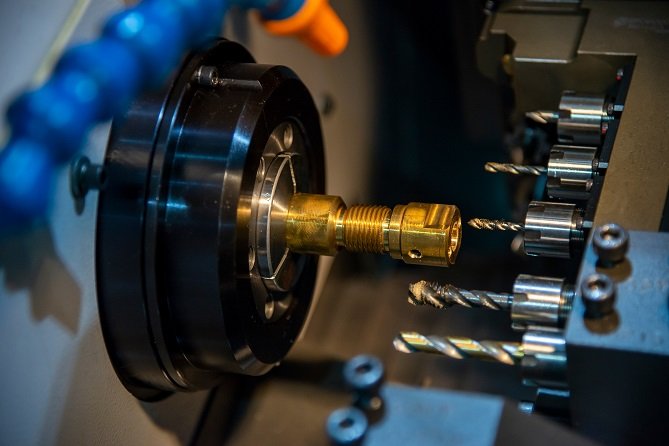How Does Swiss Turning Work?
The headstock of a conventional lathe machine is fixed, which often causes deflections during turning. What distinguishes a Swiss-type lathe from the conventional models is its headstock that moves. In a Swiss set-up, the bar stack is fed through a chucking collet in the headstock and clamped firmly. The bar enters the tooling area through a linear guide bushing, which locates the bar during turning. The headstock then moves back and forth in the Z-direction along with the bar.
To summarize, this advanced turning process can accomplish a few things that conventional lathes cannot:
1. A Swiss-type lathe eliminates the need to rotate the workpiece to turn it.
2. Swiss turning moves the workpiece along the Z axis, without moving the tooling.
3. Swiss machines feature guide bushings that hold the workpiece, allowing the cutting tool to always cut close to the point of support.
These characteristics lead to highly efficient and precise production processes that no other lathes can rival.
When Are Swiss Turning Machines Used?
As mentioned earlier, Swiss lathes in the early days were used exclusively by watchmakers, but this no longer applies today. The machine now finds its use in many sectors where parts are produced with maximum precision and efficiency. For instance, Swiss turning technology is widely used in the medical industry where very intricate surgical tools and parts of an equipment are made to the highest standard. Here is a short list of industries that make use of these state-of-the-art Swiss lathe machines:
- Watch Industry
- Automotive Industry
- Medical (Surgical Tools & Devices) Industry
- Aerospace Industry
- Fuel Systems
- Electronics & Hardware
- Military Industry
The figure below shows some common parts that are made with a Swiss-type lathe. Pay special attention to the non-round details of the parts that these machines are capable of producing.

The parts you see above are made with high precision aluminum. While aluminum is one of the most commonly used metals for turned parts, a Swiss-type machine can actually handle a wide range of materials other than aluminum, from common to extreme alloys. The following is a list of materials that a Swiss machine can handle:
- Aluminum
- Brass
- Copper
- Carbon Steel
- Monel
- Nylon
- Plastics
- Stainless Steel
- Titanium
Machine Design and CNC Capability
Today’s lathe machines more or less share similar designs, such as the sliding headstock, clamping system, etc. But what really makes a Swiss-type lathe different is its CNC controller, which makes turning a lot faster and more accurate. Owing to the added computer instructions, these advanced turning machines can now perform multiple operations on the same workpiece in a shorter amount of time. A CNC Swiss-type lathe can rotate a part up to 10,000 RPM at an exceptionally high accuracy level.
What also characterizes the CNC Swiss turning machines today is that they have the possibility for double spindles, enabling an independent C and Y axis. Many manufacturers also include a B axis for additional sets of tooling to increase the functionality even further. Moreover, the double spindle design allows the machine to run without operator’s oversight, as the workpiece is transferred automatically to the secondary operation once it’s finished. This not only saves time but also frees up manpower.
Another noteworthy feature is that you can actually have a Swiss-type lathe built without the guide bushing. Such a set-up basically allows your CNC Swiss machine to run like a standard lathe, where the headstock is fixed. This is often used when the parts to be machined are shorter and don’t require a guide bushing.. Generally speaking, you simply need to remove the bushing holder in order to disable the guide bushing.

Figure 2. CNC Swiss- Type Lathe with Sliding Headstock
Read more : A Quick Guide to Swiss Type CNC Lathe
IMTS Exhibition
IMTS gathered worldwide Swiss Lathe manufacturers into this online platform. Browse and search for your next supplier with us.
Should you run into any difficulties, please do not hesitate to contact us.
Read more : https://blog.365booth.com/2024/04/03/swiss-lathe/

